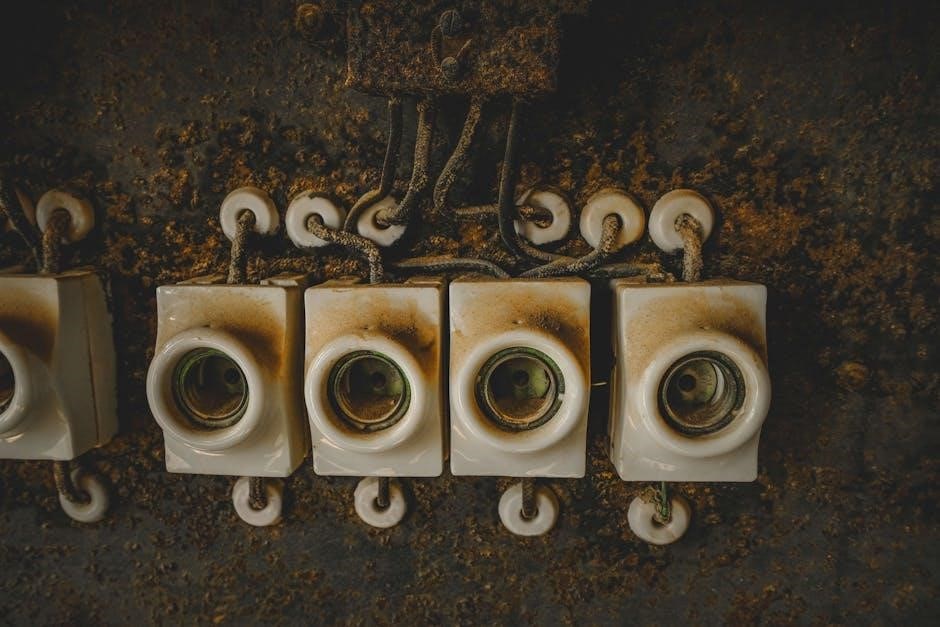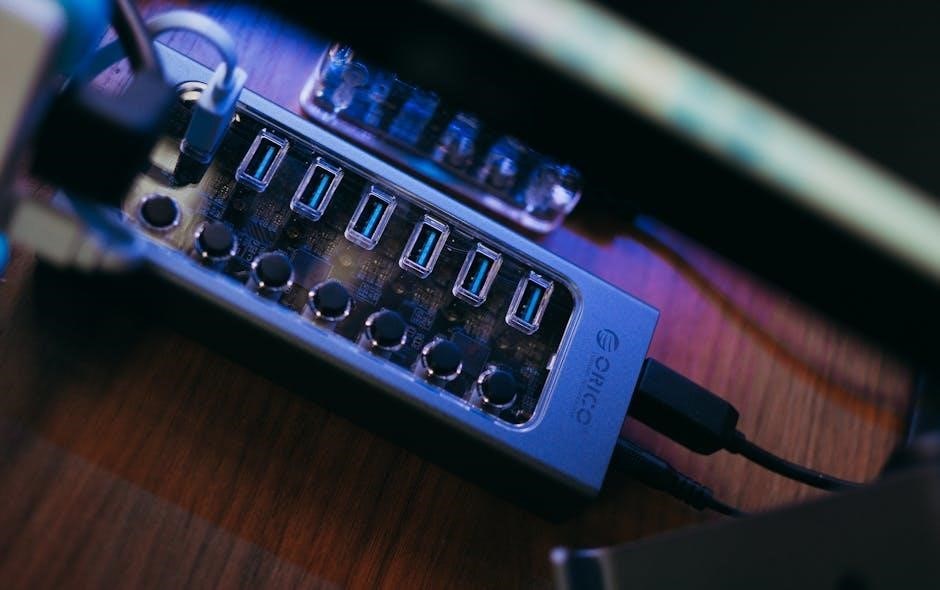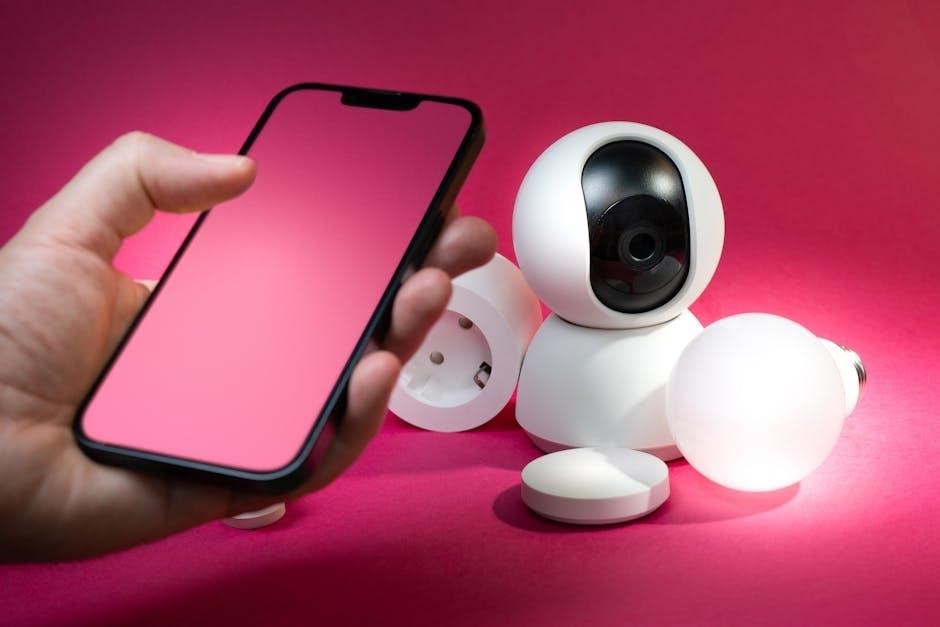A 3-way switch wiring diagram is a detailed guide for installing and understanding electrical connections; It shows how to control lighting from multiple locations using two or more switches, ensuring safe and efficient wiring. These diagrams are essential for homeowners and electricians to avoid errors and ensure compliance with electrical standards.
Overview of 3-Way Switches and Their Importance
A 3-way switch is a type of electrical switch that enables control of a light fixture from two different locations. Unlike a standard single-pole switch, a 3-way switch uses traveler wires to connect the switches, allowing for seamless control. These switches are essential in home wiring systems, particularly in hallways, staircases, and large rooms, where multiple control points are needed. The key components include terminals for the traveler wires and a common terminal, ensuring proper circuit connectivity. Understanding 3-way switches is crucial for DIY enthusiasts and electricians, as they enhance functionality and safety in lighting systems. Proper installation requires careful planning and adherence to wiring diagrams to avoid errors.
Why Use a 3-Way Switch Wiring Diagram?
A 3-way switch wiring diagram is indispensable for ensuring correct electrical connections. It provides a clear visual representation of how switches, lights, and wires interact, reducing the risk of short circuits or safety hazards. By following the diagram, individuals can accurately identify terminals, traveler wires, and common wires, simplifying the installation process. Additionally, diagrams help troubleshoot common issues, such as faulty connections or incorrect wire management. They are especially useful for beginners, offering a step-by-step guide to achieve professional results. Using a wiring diagram ensures compliance with electrical standards, making it a must-have tool for any 3-way switch project, whether for new installations or upgrades.
Components of a 3-Way Switch Wiring Diagram
A 3-way switch wiring diagram includes key components like terminals (common, traveler), wires (black, red, white, copper), and symbols representing switches, lights, and connections. These elements ensure clarity and accuracy in wiring setups.
Key Elements: Terminals, Wires, and Symbols
In a 3-way switch wiring diagram, terminals, wires, and symbols are fundamental. Terminals include the common terminal and traveler terminals, which are essential for connecting wires. Wires are color-coded: black and red for travelers, white for neutral, and bare copper for grounding. Symbols represent switches, lights, and connections, ensuring clarity. These elements work together to illustrate how power flows through the circuit, enabling precise wiring. Proper identification of these components ensures safe and efficient installation. Understanding their roles is crucial for troubleshooting and maintaining electrical systems. These visual representations simplify complex wiring setups, making it easier for DIYers and professionals to follow instructions accurately.
Understanding Traveler Wires and Common Terminals
Traveler wires and common terminals are critical in 3-way switch configurations. Traveler wires connect the two switches, allowing the circuit to function when either switch is toggled. These wires are typically red and black. The common terminal is the key connection point, linked directly to the power source or the light fixture. Proper identification ensures the circuit operates correctly. Misconnecting these can lead to faulty operation or safety hazards. Diagrams clarify their roles, making installation straightforward. Understanding their function is essential for troubleshooting and ensuring reliable control over lighting from multiple locations. This knowledge helps in avoiding common mistakes and ensures a safe electrical setup.
Basic Wiring Configurations
Basic 3-way switch wiring involves connecting power to one switch, linking it to another switch via traveler wires, and controlling a light fixture. This setup allows operation from two points, ensuring proper power routing and safe connections. Understanding the role of traveler wires and common terminals is crucial for a functional and safe installation.
Power Through the First Switch
When power is fed through the first switch, it creates a straightforward wiring configuration. The live wire connects to the common terminal of the first switch, while the traveler wires link the two switches. The neutral wire is connected directly to the light fixture. This setup ensures that the light can be controlled from either switch, providing flexibility and convenience. Proper connection of traveler wires and the common terminal is essential for the circuit to function correctly. This configuration is widely used in residential wiring due to its simplicity and reliability, making it a preferred choice for controlling lights from multiple locations. Always follow safety guidelines and wiring standards to avoid electrical hazards.
Power Through the Light Fixture
In this configuration, the power supply enters the light fixture directly, and the switches control the circuit. The live wire connects to the fixture, while the traveler wires run between the two switches. The common terminal on each switch is connected to the traveler wires, allowing the light to be toggled from either location. The neutral wire remains connected to the fixture, completing the circuit. This setup is particularly useful when the light fixture is the power source, simplifying wiring in certain installations. Proper connections ensure reliable operation, and following safety guidelines is crucial to avoid electrical hazards. This method is popular for its efficiency and ease of troubleshooting, making it a common choice in residential wiring projects.

Advanced Wiring Scenarios
Advanced wiring scenarios involve complex configurations, such as combining 3-way and 4-way switches or controlling multiple lights from several locations. These setups require precise connections and careful planning to ensure functionality and safety. Proper use of traveler wires and common terminals is critical for reliable operation. Diagrams and step-by-step guides are essential for navigating these intricate installations, ensuring all components work seamlessly together. This level of wiring demands a deep understanding of electrical principles and best practices to avoid potential hazards. Advanced scenarios are ideal for experienced electricians or skilled DIYers seeking to enhance their home’s lighting control systems.
Combining 3-Way and 4-Way Switches
Combining 3-way and 4-way switches allows for enhanced control over lighting systems, enabling operation from multiple locations. A 3-way switch must always be at the start and end of a 4-way switch circuit, with 4-way switches placed in between. This configuration ensures that the electrical current can travel through all switches without interruption. Traveler wires connect the switches, while the common terminal links to the power source or light fixture. Proper wiring is crucial to maintain functionality and safety. Diagrams and detailed instructions guide the installation process, ensuring that each wire is connected correctly. This setup is ideal for large spaces requiring versatile lighting control, such as hallways or staircases, where multiple switches are necessary for convenience. By following the correct wiring sequence, homeowners can achieve reliable and efficient lighting control systems. Understanding the role of each switch and wire is essential for successful installation and troubleshooting. Regular maintenance and checks are recommended to ensure long-term performance and safety.
Wiring Multiple Lights with 3-Way Switches
Wiring multiple lights with 3-way switches allows for flexible control of lighting in larger spaces. This setup involves connecting two 3-way switches to operate several light fixtures from different locations. The process requires careful planning and understanding of traveler wires and common terminals. Power is typically fed through the first switch, with traveler wires connecting the switches and directing the current to the lights. Each light fixture is wired in parallel to ensure independent operation. Proper wire connections and grounding are essential for safety and functionality. Diagrams provide a visual guide to ensure wires are connected correctly, avoiding short circuits or malfunctions. This configuration is ideal for controlling multiple lights in hallways, staircases, or rooms with dual access points, enhancing convenience and energy efficiency. Regular testing is recommended to ensure all lights respond correctly to switch operations.

Troubleshooting Common Issues
Troubleshooting 3-way switch issues involves checking connections, verifying power flow, and ensuring proper wiring. Common problems include lights not turning on, flickering, or switches not functioning correctly. Always test for power and inspect wires for damage or incorrect connections. Grounding issues can also cause malfunctioning, so ensure all wires are securely connected. Refer to diagrams to confirm wiring accuracy and isolate the problem by testing each component individually. Correcting faults promptly ensures safe and reliable operation of the lighting system.
Identifying and Fixing Faulty Connections

Faulty connections in 3-way switch wiring can cause lights to malfunction or not work at all. Start by turning off the power and verifying it with a voltage tester. Inspect all wire connections for looseness or damage. Common issues include incorrect traveler wire links or misconnected common terminals. Use a wiring diagram to confirm proper connections. Check for continuity between wires using a multimeter. If a connection is faulty, disconnect and reconnect it securely. Ensure all terminals are tightly screwed in and wires are properly stripped. Grounding issues can also disrupt functionality, so verify the ground wire is connected to the switch and light fixture. Fixing faulty connections requires patience and attention to detail to restore proper lighting control.
Diagnosing Issues with Light Control
Diagnosing issues with light control in a 3-way switch setup involves systematic troubleshooting; Start by checking if the light works from one switch but not the other, indicating a wiring fault. Verify if power is reaching the switches and the fixture. Use a multimeter to test for voltage at the switches and light. Check for correct wire connections, ensuring traveler wires are properly linked and the common terminal is connected to the power source. Incorrect wiring can cause the light to remain on or off. Consult a wiring diagram to confirm connections. If the light flickers or dims, it may indicate loose connections or overloaded circuits. Addressing these issues ensures reliable and consistent light control from both switches.

Best Practices for Installation
Follow safety guidelines, ensuring power is off before starting. Use a wiring diagram to plan connections. Properly ground all components and manage wires neatly. Test the circuit before finalizing.
Grounding and Safety Precautions
Proper grounding is essential for safety in 3-way switch installations. Always ensure the ground wire is connected to both switches and the light fixture. Use a voltage tester to confirm power is off before starting work. Wear insulated gloves and safety goggles to protect against electrical shocks. Never work on live circuits, and ensure all wires are securely fastened to prevent loose connections. Grounding prevents electrical hazards and ensures the system operates safely. Follow local electrical codes and manufacturer instructions for grounding procedures. Regularly inspect grounding wires for damage or corrosion. A well-grounded system minimizes risks of electrical fires and shocks, ensuring reliable performance.
Color Coding and Wire Management
Color coding is crucial for identifying wires in a 3-way switch circuit. Typically, black and red wires are traveler wires, while the white wire is neutral, and the bare copper is the ground. Properly labeling and organizing wires prevents confusion and ensures correct connections. Use wire ties or clips to manage cables neatly, reducing the risk of tangles and damage. Consistent color coding across the circuit helps in troubleshooting and future modifications. Always match the wires according to their colors to maintain the integrity of the circuit. Proper wire management enhances safety, reduces installation time, and ensures reliable electrical performance.
After completing the wiring, test the circuit to ensure all switches control the lights correctly. Verify connections, and refer to resources for further learning or troubleshooting guidance.
Final Checks and Testing
Once the wiring is complete, perform a thorough inspection to ensure all connections are secure and correct. Turn the power on at the circuit breaker and test each switch to confirm proper functionality. Verify that all lights turn on and off as intended from every switch location. Check for any unusual behavior, such as flickering lights or warm switches, which may indicate a faulty connection. Use a multimeter to test for voltage at various points if necessary. Ensure grounding is properly connected to maintain safety. If everything functions correctly, the installation is complete. If issues arise, refer back to the wiring diagram or consult additional resources for troubleshooting.
Resources for Further Learning
For those seeking to deepen their understanding of 3-way switch wiring, numerous online resources are available. Websites like cbyge.com offer detailed guides and diagrams specifically for installing and enabling 3-way switch capabilities. Additionally, project sheets and customer handouts from organizations such as the City of Santa Paula provide comprehensive wiring layouts and safety tips. Manufacturers’ instructions often include wiring diagrams and troubleshooting steps, while forums and DIY tutorials share practical experiences and solutions. These resources are invaluable for both beginners and experienced electricians looking to refine their skills or resolve complex wiring issues. Utilizing these materials ensures safe and efficient electrical work.
